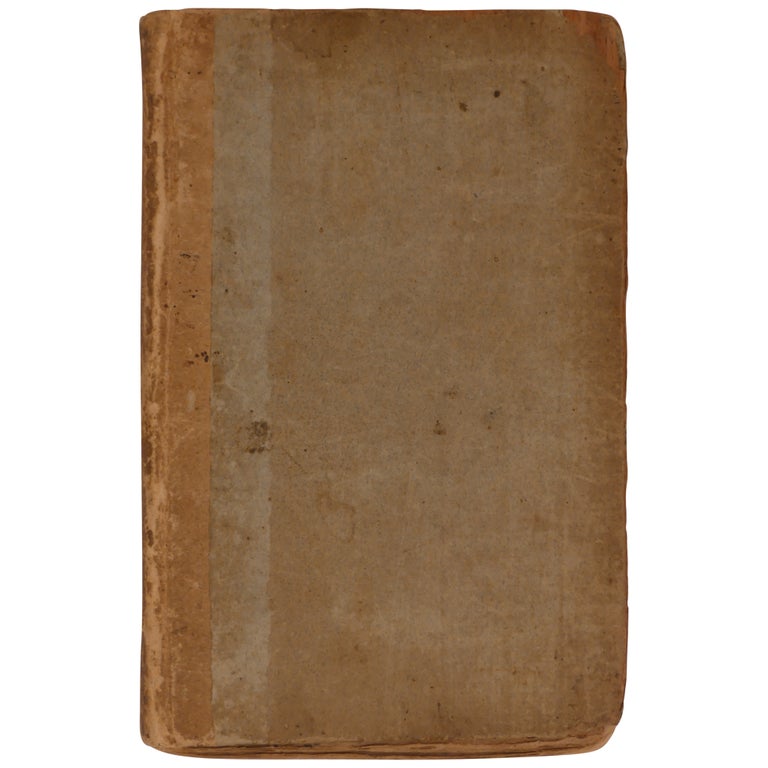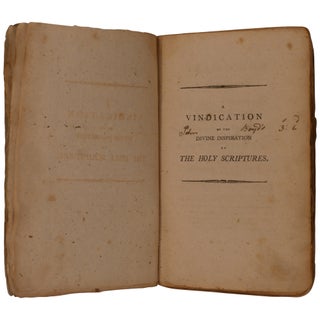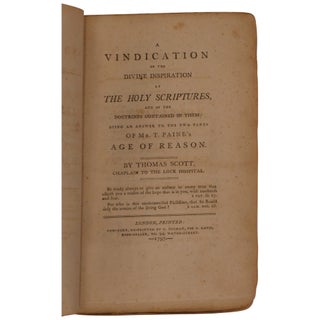18th Century American Scaleboard Binding
A Vindication of the Divine Inspiration of the Holy Scriptures and of the Doctrines Contained in Them: Being an Answer to the Two Parts of Mr. T. Paine's Age of Reason
Notes: A particularly well-preserved and distinctly American scaleboard (scabbard) binding on an 18th century religious tract responding to Thomas Paine. A friend of your cataloguer who is a wood-products professional identifies the thin wooden boards (scaleboard) used in the binding as vertical grain ash, probably sawn like veneer. On this last detail, his opinion is at odds with the conventional position that the wood was split or planed (but as the 1823 Encyclopedia Britannica noted, "scale-board ... might probably be sawed with mills to advantage", leaving the possibility that it some scaleboard was sawn in the 18th century).
Scaleboard bindings were quintessentially American bindings of the 17th and 18th century. This late example is bound in quarter sheepskin and paper-covered scaleboard. It is believed that American printers used scaleboard due to the high cost of imported pressed paper boards and because of the abundance of native wood products. In the late 18th century (and even into the 19th), these bindings are most commonly seen on religious tracts (as in this case) and school primers.
This book is the first American edition of a fiery Church of England preacher's response to Thomas Paine's Age of Reason, "which circulates widely among the lower orders." Scott rebuts The Age of Reason's arguments against the Bible, drawing on his Commentary on the Whole Bible (1788–1791), one of the most popular biblical commentaries at the time.
For more on scaleboard bindings, see Renée Wolcott's fascinating survey article, "Splintered: The History, Structure, and Conservation of American Scaleboard Bindings," The Book and Paper Group Annual, vol. 32 (2013).
The pagination for this book is typically reported as xii, [13]-202, [2] pages. This copy, however, also retains two blank leaves at the front and two more at the back. 12mo.
Edition + Condition: First American edition. This is a particularly well-preserved copy, but for a small surface chip which helpfully reveals the grain of the scaleboard. The sheets are untrimmed and the binding wholly intact, a lucky survivor because the vertical grain of the scaleboard is much more prone to splitting than the more common horizontal orientation. The original blue paper that covers the boards has tanned; the sheepskin is scuffed at the spine. In all, a wonderful example of a humble 18th century American binding.
With a late 19th century or early 20th century (?) inscription, "John Boyd's 3s. 6d. Charles F. Thompson from Grandma and Grandpa Freeland" on the first leaf and the repeated "John Boyd's 3s. 6d." on the halftitle.
Publication: New York: Re-printed by C. Forman, for C. Davis, Book-seller, 1797.
Item No: #308187
Sold



